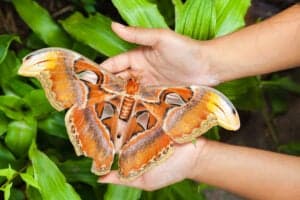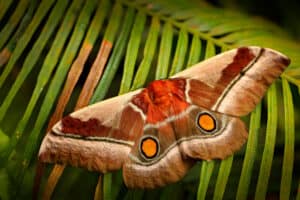Everything in nature has a meaning, and sometimes the meaning is ominous and other times, it radiates positivity. The death’s head hawkmoth is one of those ominous offerings nature lays at your feet. This is a moth that has shown up in several creepy movies and has a fog of superstition around it.
In Silence of the Lambs, the killer allegedly left an Eastern death’s-head hawkmoth (Acherontia styx) pupa behind at the scene of each murder, buried within his victim’s throats. However, it was an African death’s-head hawkmoth (Acherontia atropos). He was fascinated by these moths and raised them. This was a bit of symbolism to Buffalo Bill and those who saw themselves as the ones stuck in a metamorphosis. These moths are said to squeak, and that might be a second half of the reason they were in the throat of his victims; to be reminiscent of the screams his victims made.
The Science Behind the 3 Types of Death’s-head Hawk-moths
African Death’s-Head Hawkmoth (Acherontia atropos)

The African death’s-head hawkmoth has a more brilliant yellow on its abdomen than the greater death’s-head hawkmoth or the Eastern death’s-head hawkmoth.
©Jiri Hodecek/Shutterstock.com
Common Name: African death’s-head hawkmoth
Family: Sphingidae
Scientific name: Acherontia atropos
Appearance: These are the most commonly recognized death’s-head hawkmoth displaying a slightly lighter version of the skull-like design, which makes it stand out more. The wing patterns are dark and light brown, with an orangish-buff back wing. The underwings are yellow, which creates a big contrast between the top and bottom when they are in flight.
Size: These moths range from 4.7 to 5.2 inches in wingspan. They are close in size to the Greater death’s-head hawkmoth but larger than the Eastern death’s-head hawkmoth.
Habitat: This moth originates in Africa but makes its way to the Mediterranean and southern portions of Europe. They have been found as far north as northern Britain and the British Isles.
Diet: They prefer the nectar from local flowers and honey that they infiltrate hives to steal. It doesn’t always end well since many are found inside bee hives.
Eastern Death’s-Head Hawkmoth (Acherontia styx)
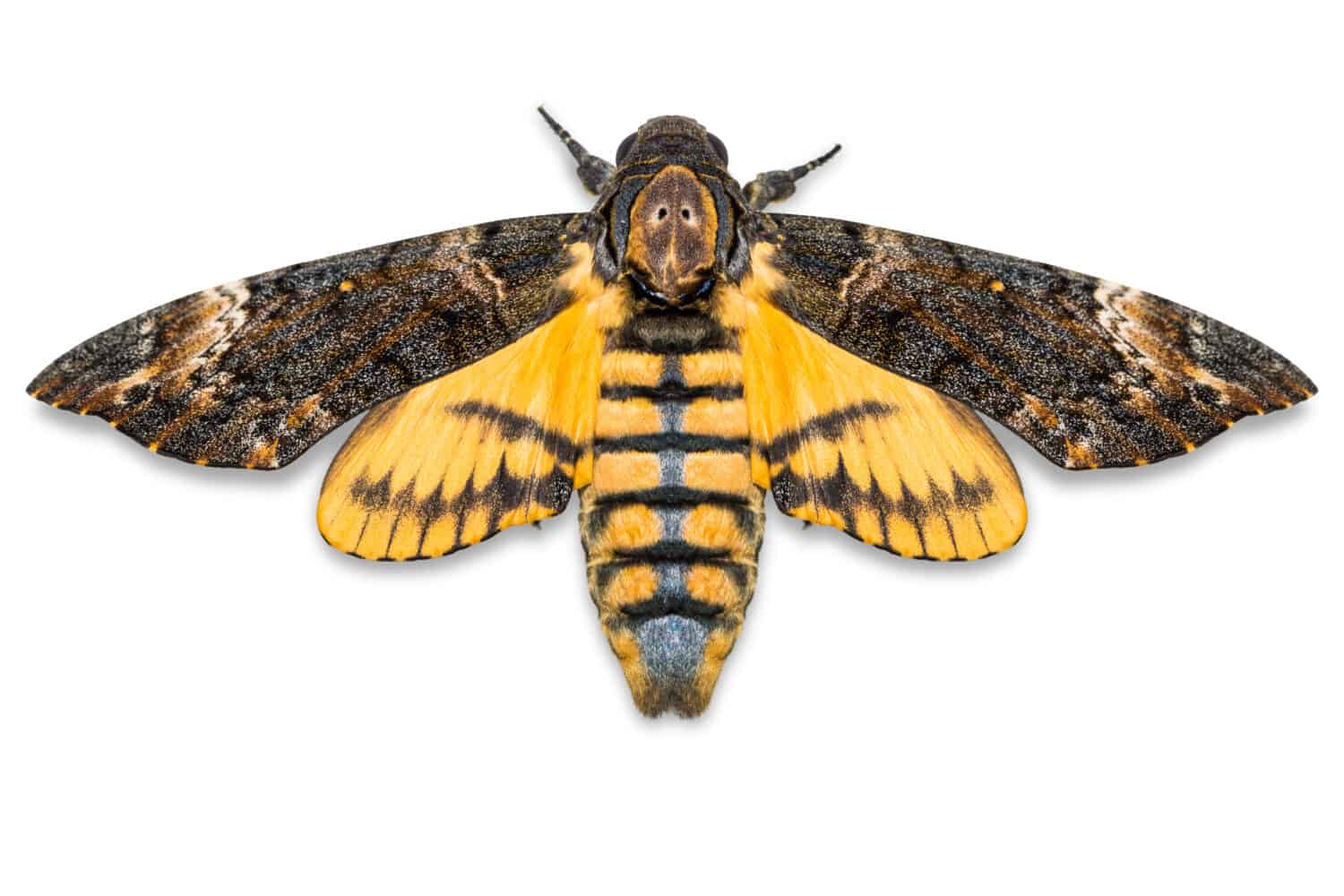
Eastern death’s-head hawkmoths have subtle yellow stripes on their large wings.
©Matee Nuserm/Shutterstock.com
Common Name: Eastern death’s-head hawkmoth
Family: Sphingidae
Scientific name: Acherontia styx
Appearance: This moth is very similar in appearance to the African death’s-head hawkmoth except for the two black medial stripes on the underside of the wings. The skull-like design is a bit dark on these moths, and the hindwing has a blue dot on the underside of the underwing.
Size: These moths are smaller than the other two moths mentioned and have a wingspan of 3.9 – 5.1 inches.
Habitat: Eastern Asia, India, Japan, Malaysia, and Thailand. They migrate from northeastern China.
Diet: Like the other hawkmoths discussed here, these moths also like honey and are often found dead inside bee hives from being stung.
Greater Death’s-Head Hawkmoth (Acherontia lachesis)
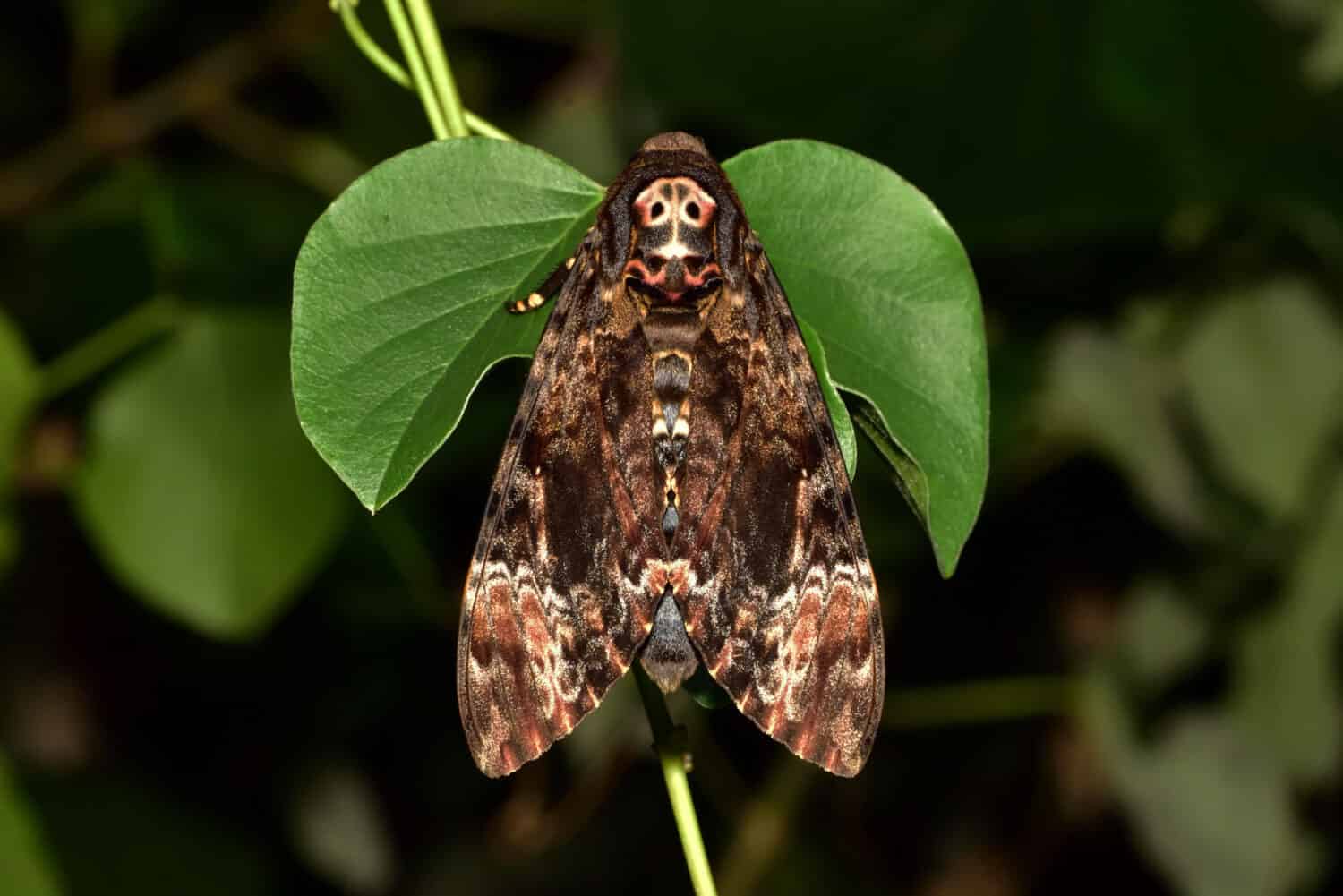
The greater death’s-head hawkmoth has beautiful, intricate patterns on its wings.
©Louis Hsu/Shutterstock.com
Common Name: Greater death’s-head hawkmoth
Family: Sphingidae
Scientific name: Acherontia lachesis
Appearance: Most of the abdomen is grey and thickly segmented, leaving only a small amount of yellow to be seen. The hindwing has a black block at the base. The rest of the wings are covered in intricate grey, brown, white, and black patterns. They also have a white spot in between the black wing stripes.
Size: Larger than the Eastern death’s head hawkmoth (Acherontia styx) at a 5.5-inch wingspan
Habitat: India, Sri Lanka, Pakistan, Nepal, southern Russia, southern Japan, Indonesia, Phillippines, and most recently became established on the Hawaiian islands.
Diet: These ominous moths love honey so much that they break into bee hives using a bee-like scent to gain entryway. They do not attack bees. They also like eating the leaves of potato plants as a caterpillar.
Creepy Scientific Name
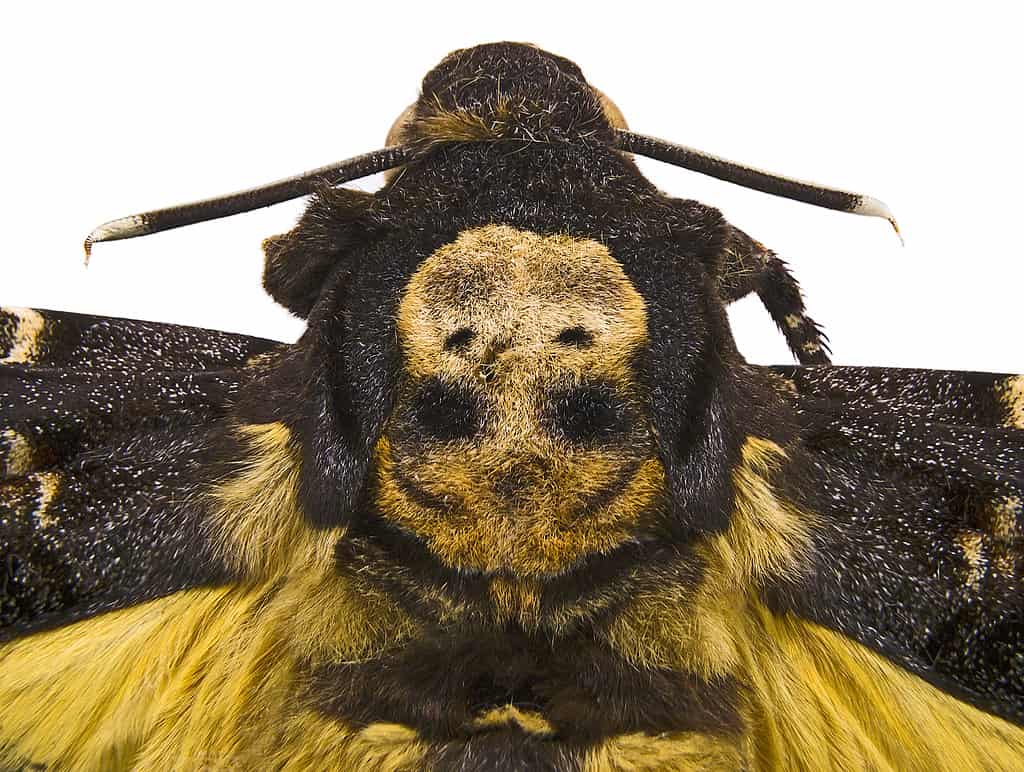
This poor hawkmoth didn’t have a chance when even its scientific name caused fear and confusion.
The scientific name for the African death’s head hawkmoth is Acherontia atropos, which is equally as ominous as its common name. The species and genus names are both derived from Greek terms having to do with scary, spooky, ominous things surrounding death.
Atropos (Greek) was one of three sisters who controlled fate and destiny. The sisters were called Moirai, which meant the sisters were the drivers of human fate and destiny. Each sister had a role to play in the dealings of life and death. The first sister was Clotho. She was the one who spun the thread of life from her distaff, and onto her spindle, this happened when a person was born. From there, the second sister, Lachesis, would measure the thread of life for each person meaning she was the scale for the balance of a person’s life dependent on his/her choices and their consequences. Of the three, Atropos was the one who cut the thread of life. She knew how a person would die, and when their time came, she would cut their life’s thread with her abhorred shears. She was Death.
The species name, Acherontia, is derived from Acheron, which is a river in Greece. In ancient mythology, the river led to the underworld. This was decided due to the dark, scary gorges that the river flowed through.
The Eastern Death’s head hawkmoth’s genus is styx is Greek for the river that ran through the underworld and also the goddess who controlled it. The greater death’s head hawkmoth’s genus name is lachesis, which is the second Moirai sister’s name. She was the one who measured life’s thread.
Folklore and Superstition
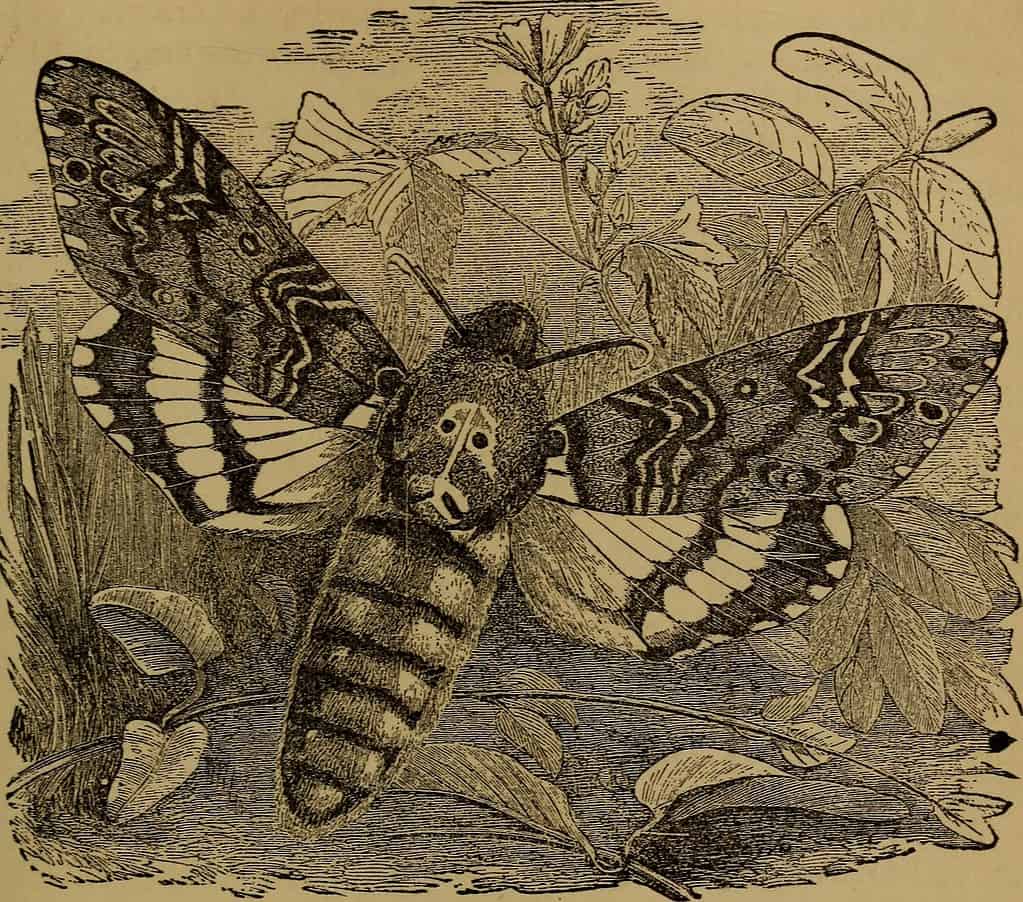
The death’s head hawk-moth has appeared in numerous books and movies, like this one, “
Little Folks in Feathers and Fur, and Others in Neither
” published in 1875.
©Internet Archive Book Images / CC0 1.0, Flickr – Original / License
As far as folklore and superstitions, the death’s-head hawkmoth has shown up numerous times in stories, movies, and songs. The most notable was in Silence of the Lambs, the movie, and the book. The death’s head hawkmoth was on the covers for both. In Bram Stoker’s Dracula, the death’s head hawkmoth was fed to Renfield, Dracula’s assistant. Also, in King George III’s bed chamber, three death’s-head hawkmoths were found and pushed him further into insanity. When King Charles I was sentenced to death, the death’s head hawkmoth was said to have been first seen in Great Britain. Throughout Europe, the death’s-head hawkmoth was a harbinger of war, pestilence, and death to man and beast. Not very nice when we are just talking about a moth doing its best to live a good life.
List of Myths
- In Europe, if the moth were seen in a candlelit room, and especially if the light were snuffed out by the moth, death would occur in the house.
- In France, if dust from the moth’s wing were to get into the eye, it would cause blindness.
- In Poland, the death’s-head moth is known as the “wandering bird of death,” and its squeak was compared to a voice of anguish, such as the moaning of a grief-stricken child.
- Also, in Europe, the death’s-head hawkmoth is said to be the soul of a deceased person who was unable to rest.
- In Shakespeare’s play Macbeth, the moth was a warning of doom.
- The death’s-head hawkmoth is the mascot of the Death Eaters, a group of evil witches, in Harry Potter.
- It has been hinted that having the death’s-head hawkmoth tattooed can invoke memories of our deaths from former lives. It can also symbolize mortality and aid in our ability to face fear, guilt, and sacrifice.
- Carribean cultures believe that if one finds a dead death’s-head hawkmoth, your death will come soon.
- Many cultures believe that the moth symbolizes rebirth since it metamorphizes from a caterpillar to a moth and also because the wings are still but come to life to fly toward the light.
- Native Americans believe the moths carry messages from the dead and are linked to other worlds.
- The death’s-head moth brings on a depressed state if you approach it.
Spirituality of the Death’s-Head Hawkmoth

©ju_see/Shutterstock.com
Like most other things found in nature, the death’s-head hawkmoth can mean a tremendous amount of different things. The moth can mean rebirth after death or can stand for something that you must give up or let go of in order to continue with life. Some believe the moth symbolizes the changes that you are experiencing will lead to metamorphosis and growth as a person. The moth’s ability to fly through darkness can be interpreted in many ways. Some of those ways are vulnerability and belief.
Traditions, superstitions, and beliefs will go as far and as long as the mind cares to support them. Is there any truth behind it? Some swear there definitely is, and some simply see a beautiful moth with intricate designs in hopes of fooling a predator. However, there is something to be said about a living being that is attracted to what causes it the most harm. After all, nothing good ever comes from a moth being attracted to light.
Thank you for reading! Have some feedback for us? Contact the AZ Animals editorial team.





